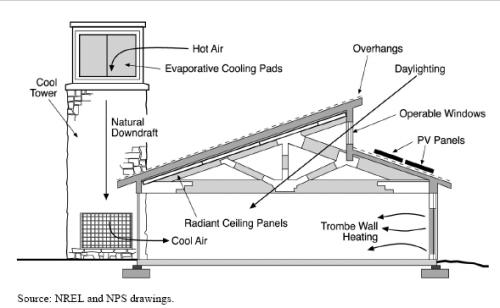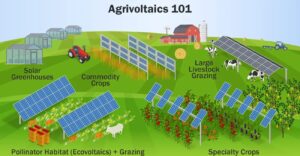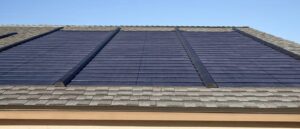Passive solar cooling may seem like an oxymoron to many. After all, the sun is hot and we’ve learned that radiant energy heats up everything on earth that it strikes? That is true and we can use it to our advantage.

Keeping things cool
The first step in passive solar cooling is to simply keep the building from heating up in the first place. Think of all the things that heat up a building:
- The sun
- Lighting
- Computers, etc
- Appliances
- Occupants
Let’s start with the sun. We can reduce the effects of the sun by properly siting a building with a long east/west orientation that utilizes thermal mass and appropriate glazing and window frames. We can also provide shading with exterior architectural features and trees primarily on the south and west. It is important not to block summer breezes as these can help radiate heat away and even pass through the structure.
The next largest heat load tends to be lighting. Through the use of properly implemented daylighting strategies and LED task lighting that heat load can be almost completely eliminated.
There isn’t a lot that can be done with computers and other technology since it is so ubiquitous in our world. However, we can use technology that has a sleep mode when not in use and processors that operate slower and with less heat when we are doing low impact tasks. Even turn off or hibernate computers of occupants who are not there at the time. Proper energy management goes a long way in reducing energy loads.
What office or home doesn’t have a refrigerator or other appliances? The use of low energy appliances reduces heating loads since they are creating less heat through electricity usage.
There isn’t much that can be done about the occupants. With out them we wouldn’t even be having this discussion.
Solar Chimneys
At this point I know you are asking how the sun can be used to cool a building. The simplest way is to create a solar chimney. This is a structure that is referred to as a stack. The stack is essentially a taller portion of the building similar to a tower. It is also a great opportunity for an architectural feature.
The top of the stack is generally black or some dark color and has operable openings. An insect screen is a good idea. The sun heats up the black surface which in turn heats up the surrounding air. This then creates an upward draft since warm air rises. This draws cool air through the building. This cool air can come from a vegetated area, which are typically a few degrees cooler than surrounding air, or through tubes that pass through the earth.
Cool Tower
An alternative to the solar chimney is the cool tower. This also uses a stack feature but works similar to an evaporative cooler. At the top of the tower is an evaporative cooler that draws in air and cools it as it passes through a wet medium. That cool air then falls down the stack and into the space. The motion of the air is supplemented with clerestory windows that allow warm air to be drawn out of the space.
With proper modeling the cool tower can be designed to keep the building cool throughout the warm months. Additional features that go hand in hand with a cool tower are appropriate thermal mass, minimization of summer solar heat gain and supplemental fans to assist in air circulation when needed.
It soon becomes apparent that sustainable design doesn’t hinge on one particular solution. Rather there are a variety of solutions that need to be combined in various ways in order to create a workable solution for a particular building type and climate. Through understanding the fundamentals we have springboard into more in depth considerations and solutions.










1 thought on “Passive Solar Cooling – Solar Chimneys & Cool Tower”
Pingback: The Solar Chimney | Uses of Solar Power
Comments are closed.